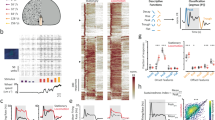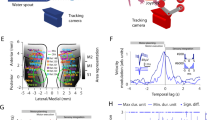Abstract
INFORMATION processing in the cerebral cortex invariably involves the activation of millions of neurons that are widely distributed over its various areas. These distributed activity patterns need to be integrated into coherent representational states. A candidate mechanism for the integration and coordination of neuronal activity between different brain regions is synchronization on a fine temporal scale1–3. In the visual cortex, synchronization occurs selectively between the responses of neurons that represent related features2–5 and that need to be integrated for the generation of coherent percepts; neurons in other areas of the cerebral cortex also synchronize their discharges6–10. However, little is known about the patterns and the behavioural correlates of synchrony among widely separated cortical regions. Here we report that synchronization occurs between areas of the visual and parietal cortex, and between areas of the parietal and motor cortex, in the awake cat. When cats responded to a sudden change of a visual pattern, neuronal activity in cortical areas exhibited synchrony without time lags; this synchrony was particularly strong between areas subserving related functions. During reward and inter-trial episodes, zero-time-lag synchrony was lost and replaced by interactions exhibiting large and unsystematic time lags.
This is a preview of subscription content, access via your institution
Access options
Subscribe to this journal
Receive 51 print issues and online access
$199.00 per year
only $3.90 per issue
Buy this article
- Purchase on SpringerLink
- Instant access to full article PDF
Prices may be subject to local taxes which are calculated during checkout
Similar content being viewed by others
References
Abeles, M. Corticonics (Cambridge Univ. Press, 1991).
Singer, W. & Gray, C. M. Annu. Rev. Neurosci. 18, 555–586 (1995).
Engel, A. K., König, P., Kreiter, A. K., Schillen, T. B. & Singer, W. Trends Neurosci. 15, 218–226 (1992).
Gray, C. M., König, P., Engel, A. K. & Singer, W. Nature 338, 334–337 (1989).
Eckhorn, R. et al. Biol. Cybern. 60, 121–130 (1988).
Bouyer, J. J., Montaron, M. F. & Rougeul, A. Electroencephalogr. Clin. Neurophysiol. 51, 244–252 (1981).
Murthy, V. N. & Fetz, E. E. Proc. Natl Acad. Sci. USA 89, 5670–5674 (1992).
Sanes, J. N. & Donoghue, J. P. Proc. Natl Acad. Sci. USA 90, 4470–4474 (1993).
Vaadia, E. et al. Nature 373, 515–518 (1995).
Bressler, S. L., Coppola, R. & Nakamura, R. Nature 366, 153–156 (1993).
Scannell, J. W., Blakemore, C. & Young, M. P. J. Neurosci. 15, 1463–1483 (1993).
Felleman, D. J. & Van Essen, D. C. Cereb. Cortex 1, 1–47 (1991).
Maunsell, J. H. R. & Newsome, W. T. Annu. Rev. Neurosci. 10, 363–401 (1987).
Goodale, M. A. & Milner, A. D. Trends Neurosci. 15, 20–25 (1992).
Kalaska, J. F. & Crammond, D. J. Science 255, 1517–1523 (1992).
Jeannerod, M., Arbib, M. A., Rizzolatti, G. & Sakata, H. Trends Neurosci. 18, 314–320 (1995).
Mitzdorf, U. Physiol. Rev. 65, 37–100 (1985).
Engel, A. K., Kreiter, A. K., König, P. & Singer, W. Proc. Natl Acad. Sci. USA 88, 6048–6052 (1991).
Frien, A., Eckhorn, R., Bauer, R., Woelbern, T. & Kehr, H. Neuroreport 5, 2273–2277 (1994).
Nelson, J. I., Salin, P. A., Munk, M. H. J., Arzi, M. & Bullier, J. Vis. Neurosci. 9, 21–37 (1992).
Roelfsema, P. R., Engel, A. K., König, P. & Singer, W. J. Cogn. Neurosci. 8, 603–625 (1996).
Engel, A. K., König, P., Kreiter, A. K. & Singer, W. Science 252, 1177–1179 (1991).
Munk, M. H. J., Nowak, L. G., Nelson, J. I. & Bullier, J. J. Neurophysiol. 74, 2401–2414 (1995).
Buchwald, N. A., Horvath, F. E., Wyers, E. J. & Wakefield, C. Nature 201, 830–831 (1964).
Steriade, M., McCormick, D. A. & Sejnowski, T. J. Science 262, 679–685 (1993).
Munk, M. H. J., Roelfsema, P. R., König, P., Engel, A. K. & Singer, W. Science 272, 271–274 (1996).
Steriade, M., Amzica, F. & Contreras, D. J. Neurosci. 16, 392–417 (1996).
Nieoullon, A. & Rispal-Padel, L. Brain Res. 105, 405–422 (1976).
Tusa, R. J., Palmer, L. A. & Rosenquist, A. C. J. Comp. Neurol. 177, 213–236 (1978).
Author information
Authors and Affiliations
Rights and permissions
About this article
Cite this article
Roelfsema, P., Engel, A., König, P. et al. Visuomotor integration is associated with zero time-lag synchronization among cortical areas. Nature 385, 157–161 (1997). https://doi.org/10.1038/385157a0
Received:
Accepted:
Issue Date:
DOI: https://doi.org/10.1038/385157a0



